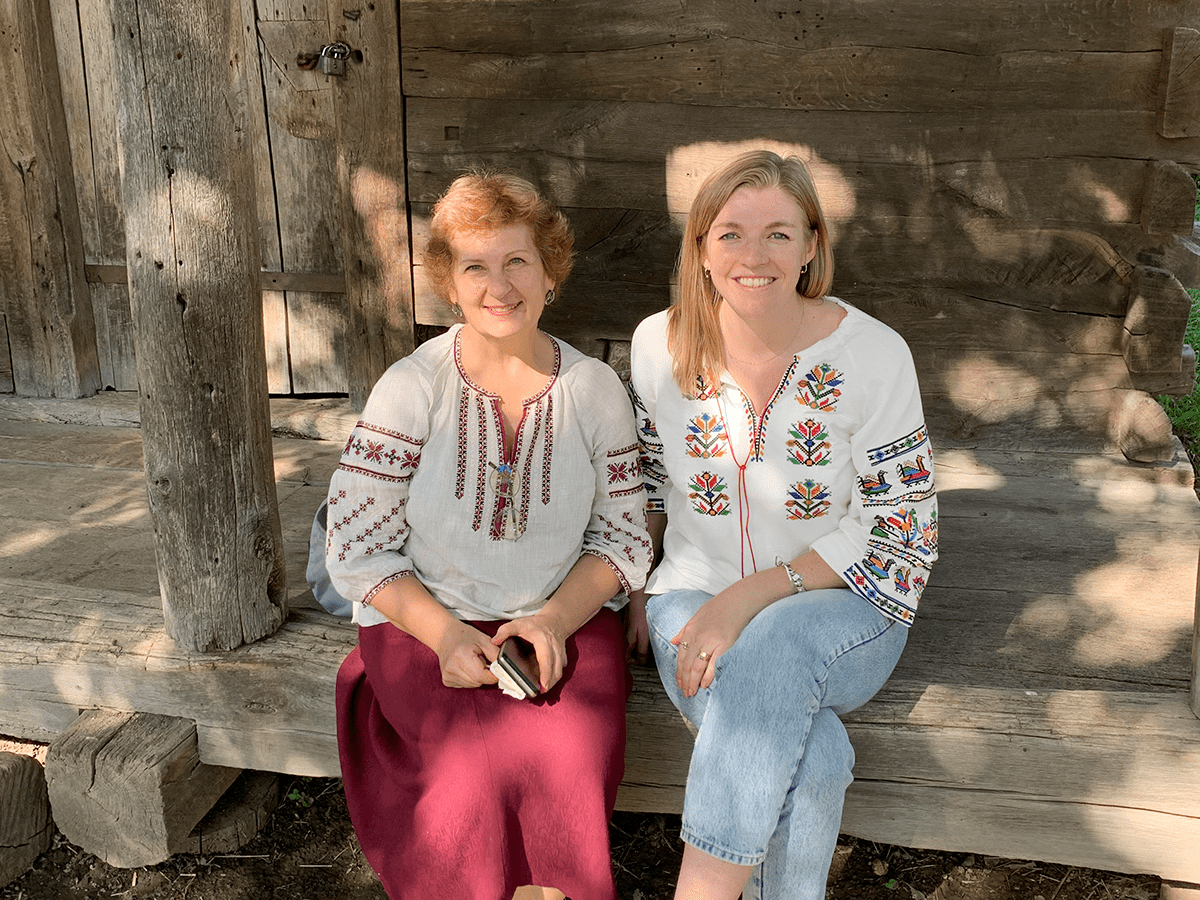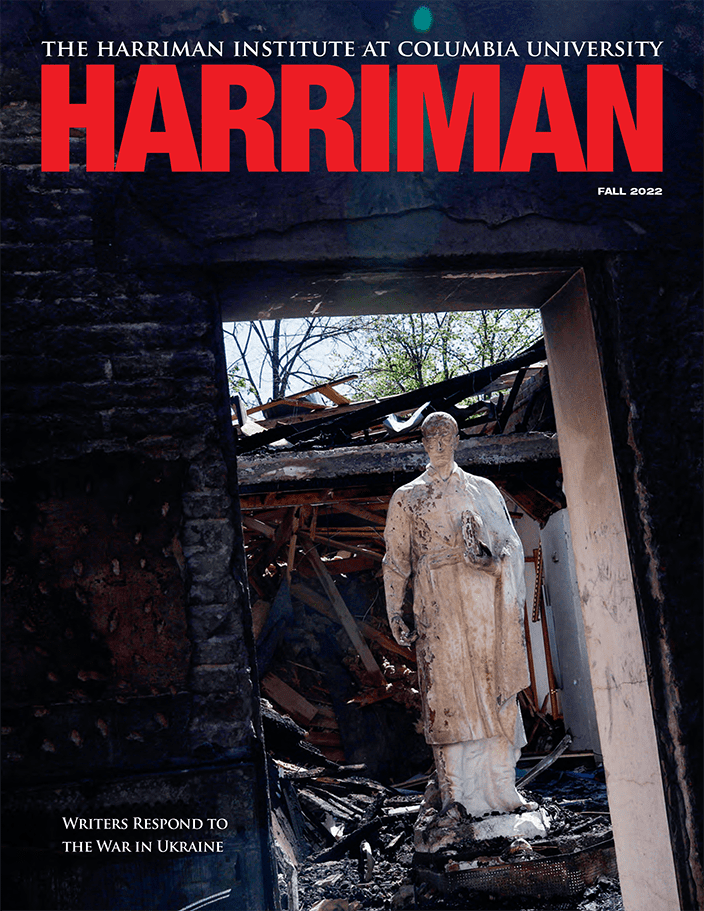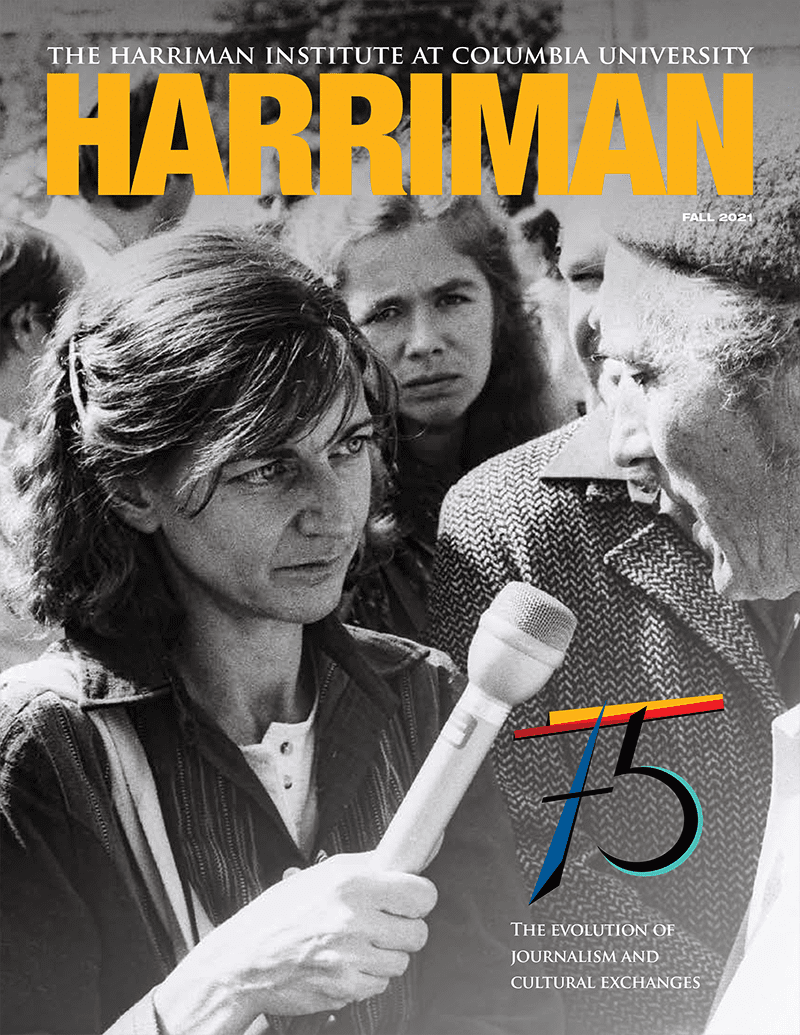Researching grassroots resistance movements in wartime Ukraine.
I wasn’t sure what to expect this past summer as I entered a windowless warehouse in the suburbs of Dnipro in southeastern Ukraine. Someone turned on the lights, illuminating dozens of cardboard boxes stacked on metal shelves and spread across the bare concrete floor. Some gaped open, revealing military clothing, water filters, tourniquets, and all manner of tactical medical supplies. Next to a box overflowing with trench candles stood a spent artillery casing. And on a table in the center of the room was a stack of children’s drawings, addressed to soldiers.
Everything inside was destined for Ukrainian troops fighting Russia’s invasion, but this was no military storeroom. I was on the premises of a small volunteer organization; its name, emblazoned across a Ukrainian flag, provided the only color in this room of grey and brown: Bakhmut Ukrainian. As the name implies, the grassroots organization is from the city of Bakhmut in Ukraine’s eastern Donetsk region, now on the frontlines of Russia’s war in Ukraine. Today Bakhmut Ukrainian has relocated to Dnipro, considered more secure. But until February 2023, a few volunteers remained in their hometown, helping those living and fighting there, even as the Russian army destroyed the city around them.
Bakhmut Ukrainian gathers money and goods to support those fighting on the frontlines with key items, such as life-saving medical supplies. But what the troops appreciate most, the organization’s director told me, are the children’s pictures—colorful drawings with flags and smiling soldiers, emblazoned with the words “thank you!” and “glory to Ukraine!”—which they use to brighten up their barracks and raise their spirits. As for the waist-high artillery casings in the corner, they’re a “present” to the volunteers from one of the military units they support. For local Ukrainian groups—unlike international humanitarian organizations—there is little separation between military aid and humanitarian help: more support for the armed forces means a shorter war, and less civilian suffering.
The lines between civilians and the military blur in another way, too. These volunteers from Bakhmut were civilians in the crossfire; now they are vital support in the rear, providing troops with supplies to stay alive and do their jobs more effectively.
I’m a sociologist writing about the war in Ukraine. But I don’t focus on military maneuvers or the destruction wrought by the Russian military. I study the ways in which ordinary Ukrainians—particularly those whose lives have been most acutely impacted by this invasion—contribute to Ukraine’s resistance.
Scholarship on civilians in wartime generally anticipates they will either flee or stay and fight. But in Ukraine, many have chosen a third option: to stay, but to participate in the war effort as noncombatants. It was this choice that I sought to examine in my summer 2023 fieldwork.
I was unable to travel to Bakhmut, which has been almost entirely destroyed. Bakhmut’s pre-war civilian population of 73,000 has largely been displaced across Ukraine and beyond. But I did interview a number of people from the city, now living elsewhere in Ukraine, about their experiences of engaging in the war effort. Although my research did not focus exclusively on people from Bakhmut, the stories from this city in particular demonstrate that even the very worst of Russia’s destruction is met with resistance and defiance by ordinary Ukrainians—including in Ukraine’s eastern regions, where Russia mistakenly expected to be welcomed with open arms.
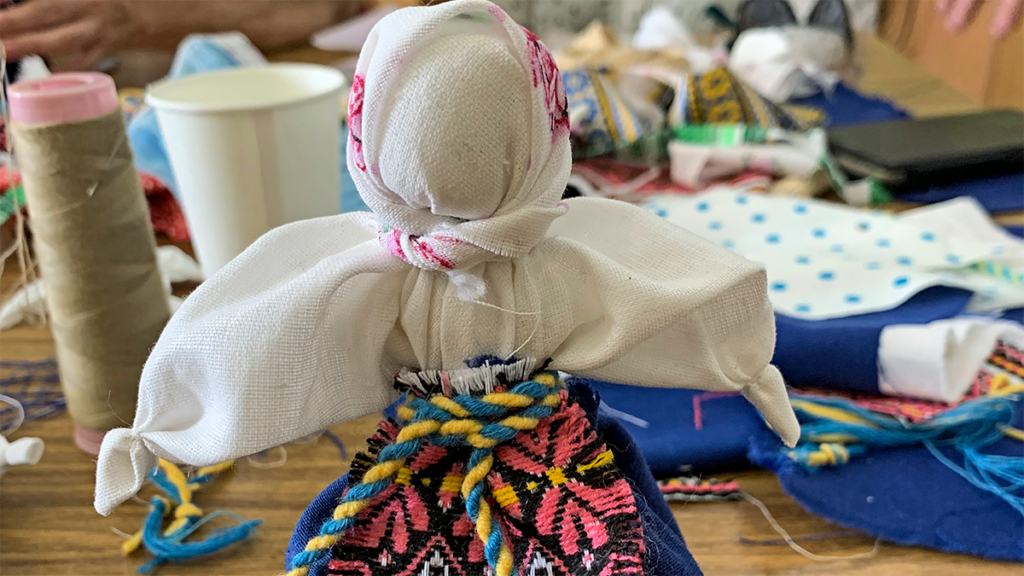
The author’s finished doll, made at Svitlana’s workshop.
Bakhmut, now known throughout the world for its annihilation by Russia, used to be referred to by its residents as the City of Roses. In February 2022, when Russia launched its full-scale invasion, Bakhmut did not feel like a critically dangerous place, according to many of my interviewees. My sources told me they didn’t panic in early 2022 because they thought it would be like before: the Ukrainian Army would fight back, and there wouldn’t be too much destruction. That is what happened in the spring of 2014, after pro-Russian rebels staked a claim there; by early July that year, Ukrainian forces had fully recovered control, without significant destruction.
In the years that followed, Bakhmut remained close to the frontlines of the war in eastern Ukraine, though the city itself was peaceful. Many of the people I interviewed emphasized that in 2022, most people stayed in Bakhmut not because they were waiting to welcome the Russians. They stayed because they thought Bakhmut would endure and remain in Ukrainian hands.
“…the stories from this city in particular demonstrate that even the very worst of Russia’s destruction is met with resistance and defiance by ordinary Ukrainians.”
Many people I spoke to fled only when the shelling finally reached their neighborhoods. Several told me that when they did finally leave, they took only a couple of suitcases, thinking they would be back soon. Now their homes and all the possessions they left behind are gone.
And yet—and this is my biggest concern with the way Bakhmut is perceived by the wider world—these people are not helpless victims of Russia’s war, as media portrayals may indicate. Many of them, such as the volunteers at Bakhmut Ukrainian, are part of Ukraine’s resistance.
Svitlana, one of these volunteers, showed me that this resistance can manifest in many different ways. She spends a lot of time at the Bakhmut Ukrainian warehouse, sorting and distributing donations. But she also supports her fellow displaced Ukrainians by other means—as a master of Ukrainian folk art who runs workshops teaching dollmaking and other traditional Ukrainian crafts to internally displaced people. Svitlana, who obtained her master’s degree in psychology so she could help people traumatized by the onset of Russia’s war in 2014, explained to me that the years of watching Ukrainians make dolls have led her to notice a transformation that often takes place during the workshops. Participants achieve a state of calm, she said, and they begin “to be proud of themselves because they’ve made something beautiful. And not only that—they start to feel Ukrainian, and familiar with Ukrainian culture.”
“Many people I spoke to fled only when the shelling finally reached their neighborhoods. Several told me that when they did finally leave, they took only a couple of suitcases, thinking they would be back soon. Now their homes and all the possessions they left behind are gone.”
Svitlana invited me to one of these workshops to see for myself. When we introduced ourselves at the start of the session, most of the attendees stated their hometowns as places we know from news stories about the war: Bakhmut, Pokrovsk, Severodonetsk. At the start, the mood in the room was subdued—some women struggled to identify just one good thing that had happened to them that week. But, by the end of the session, all had smiles on their faces and traditional dolls in their hands. One woman shared that assisting a neighbor with her doll made her feel like she wasn’t powerless, because she could do something helpful for another. Maybe this is the reason why so many Ukrainians engage in the war effort.
Svitlana, and a number of others I interviewed from Bakhmut, volunteered in various ways long before 2022. Ukraine has a flourishing civil society stretching back to the 2013–14 Euromaidan protests, which ousted President Viktor Yanukovych, and beyond. Time and again, Ukrainians have risen up to challenge corrupt leaders, or threats to their freedom. This history of civic engagement, something I have been studying for almost a decade, has empowered many Ukrainians to engage in the war effort.
Unlike Svitlana, others are now volunteering for the first time. I met two childhood friends from Bakhmut, Nastya and Olya, who started a new NGO in early 2023. Both are internally displaced and work to help families and children in areas neglected by other organizations: they throw a party for children in a town and then provide the families who attend with much-needed school supplies and hygiene and food items. Nastya and Olya named their organization “We Are Bakhmut” because they wanted to show that Bakhmut still exists as a community of people contributing toward Ukraine’s victory.
I asked Nastya, as I did all my interviewees, if she had engaged in any volunteering or civic activities before the full-scale invasion. She said no, but, not long after, acknowledged that she used to host troops in her Bakhmut home, feeding soldiers and doing their laundry.
Similar stories emerged in other interviews. People would tell me that they weren’t volunteers, then describe actions that, from a Western perspective, could very much be considered volunteering. Ihor, an older man from Bakhmut, initially told me that before leaving Bakhmut in the summer of 2022, he had been too busy working as a high school teacher to volunteer. But later, he recalled how he helped local military personnel find safe housing in the city—and how his students had made camouflage nets for the military.
Lyudmila also told me she didn’t really volunteer since being displaced from Bakhmut to Dnipro; having lost everything, she depended on external support, and she also had to look after her grandchildren. I suggested that this was important, too, and she agreed: “Yes, they’re our future. If not me then who will help them? Right now, schools aren’t working, kindergarten isn’t working, someone needs to be with them. That’s also my ‘front,’ ” she laughed. But it turned out Lyudmila contributes in other ways too: when she has some free time, she often helps at the warehouse of Bakhmut Ukrainian, sorting supplies donated to military units.
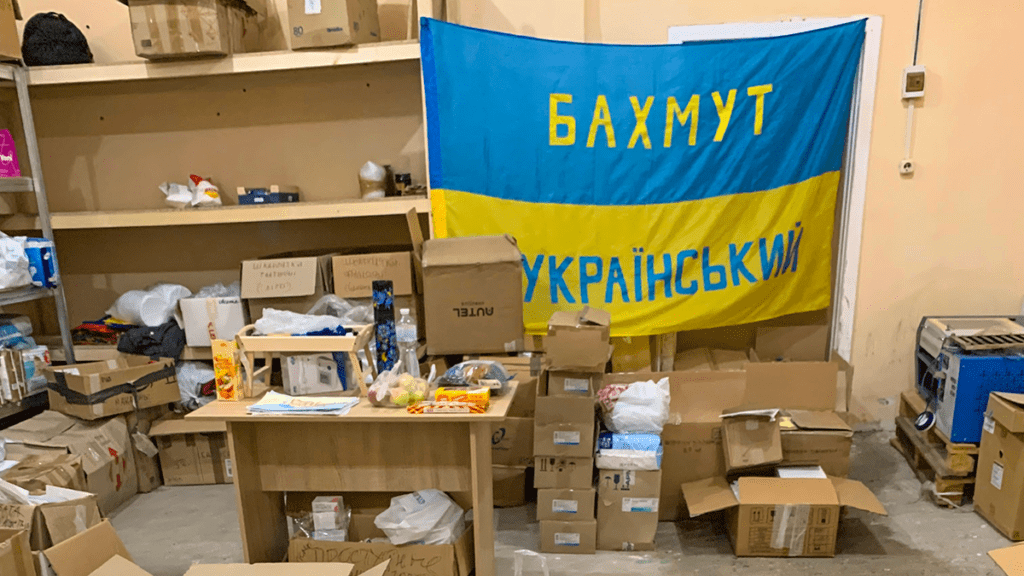
The warehouse of Bakhmut Ukrainian, featuring a flag bearing the organization’s name, boxes of tourniquets and medical equipment, and children’s drawings on the table.
The reality is that many Ukrainians are playing an active role in the war effort. Surveys by my colleagues at MOBILISE (mobiliseproject.com)—an international research project that studies mass protest and migration—suggest that around 80 percent of those in Ukraine are engaging in the war effort in some way. We might expect the Ukrainians most directly affected by the war—those who have lost homes, jobs, and loved ones—to be less likely to volunteer as they deal with trauma and financial or emotional hardships. But my research this summer shows something different: those who have suffered greatly may be highly motivated to support Ukraine’s resistance. It is important to acknowledge that this may not be true for all displaced people; my interviews do not represent the whole population. Nevertheless, the people I spoke with from Bakhmut want to prevent more Ukrainians from losing their homes. They also want to help others who have already suffered this trauma.
Of all the people I interviewed this summer, the most hopeful were volunteers from Bakhmut. Many are steadfastly convinced that Ukraine will win the war and their city will be rebuilt. Svitlana told me about her plans to create a museum and center for Ukrainian culture in liberated Bakhmut: “I am convinced that after our victory, my dream will come true.” She said she even has a plot of land in mind to build on. As we walked together through Dnipro, I saw her collect seeds and plant cuttings to sow in her garden when she finally returns. Svitlana is certain that Bakhmut will flourish once again, a city of roses. ◆
Featured photo (at the top): The author (right) and Svitlana, wearing vyshyvankas, traditional Ukrainian embroidered shirts.
Some names have been changed.
This research trip was possible thanks to a Harriman Institute PepsiCo Summer Travel Grant.
Emma Mateo is Petro Jacyk Postdoctoral Scholar in Ukrainian Studies at the Harriman Institute. She is a sociologist who studies protest, activism, and civil society in Ukraine and Eastern Europe.

